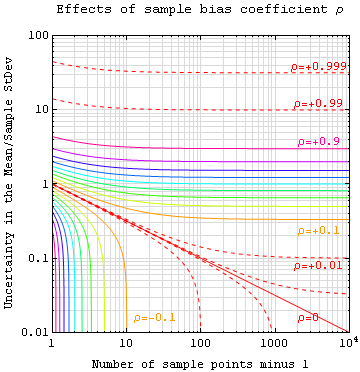Image: SampleBiasCoefficient
Description: An estimate of expected error in the (sample estimate of the population) mean of variable A sampled at N locations in a parameter space x, can be expressed in terms of sample bias coefficient ρ defined as the average auto-correlation coefficient ρAA[Δx] over all sample point pairs. This generalized error in the mean is the square root of: sample variance (treated as a population) times (1+(N-1)ρ)/((N-1)(1-ρ)). The ρ=0 line (of log-log slope -½) is the more familiar standard error in the mean for samples that are uncorrelated. Example: For a 3D fragment of size D taken from a collection of differing and randomly-distributed but homogeneous grains of size d, sample bias may be approximated by ρ ≈ 1-(D/d)+(2/7)(D/d)2 when D≤d and ρ ≈ (2/7)(d/D)5-(d/D)4+(d/D)3 when D>d. Hence an equidimensional fragment about 4.2 times the grain size will have ρ~0.01 and leave you with uncertainty in the population mean of no less than about 10% of the sample standard deviation, regardless of how many points within that fragment are sampled. Notes: The "Sample StDev" mentioned in the vertical axis label is the square root of sample variance (treated as a population), rather than the ρ=0 sample-based estimate of population standard deviation which differs from the former by a factor of Sqrt[N/(N-1)]. The unbiased nature of this estimate is shown valid for arbitrary samples in Appendix 5 of P. Fraundorf (1980) "Microcharacterization of interplanetary dust collected in the earth's stratosphere" (Ph.D. Dissertation in Physics, Washington University, Saint Louis MO).
Title: SampleBiasCoefficient
Credit: Own work
Author: P. Fraundorf
Usage Terms: Creative Commons Attribution-Share Alike 3.0
License: CC BY-SA 3.0
License Link: http://creativecommons.org/licenses/by-sa/3.0
Attribution Required?: Yes
Image usage
The following page links to this image:


